Vite學習之深度解析「依賴掃描」

前端(vue)入門到精通課程:進入學習
當我們首次執行 Vite 的時候,Vite 會執行依賴預構建,目的是為了相容 CommonJS 和 UMD,以及提升效能。【相關推薦:】
要對依賴進行預構建,首先要搞清楚這兩個問題:
預構建的內容是什麼?/ 哪些模組需要進行預構建?
如何找到需要預構建的模組?
這兩個問題,其實就是依賴掃描的內容以及實現方式。
本文會深入地講解依賴掃描的實現細節,最終的掃描結果是一個包含多個模組的名字的物件,不涉及預構建的過程、預構建產物如何是使用的。如果對該部分內容感興趣,可以關注我,等待後續文章。
依賴預構建的內容
一個專案中,存在非常多的模組,並不是所有模組都會被預構建。只有 bare import(裸依賴)會執行依賴預構建
什麼是 bare import ?
直接看下面這個例子
// vue 是 bare import import xxx from "vue" import xxx from "vue/xxx" // 以下不是裸依賴 import xxx from "./foo.ts" import xxx from "/foo.ts"
可以簡單的劃分一下:
- 用名稱去存取的模組是裸模組
- 用路徑去存取的模組,不是 bare import
實際上 Vite 也是這麼判斷的。
下面是一個常見的 專案的模組依賴樹
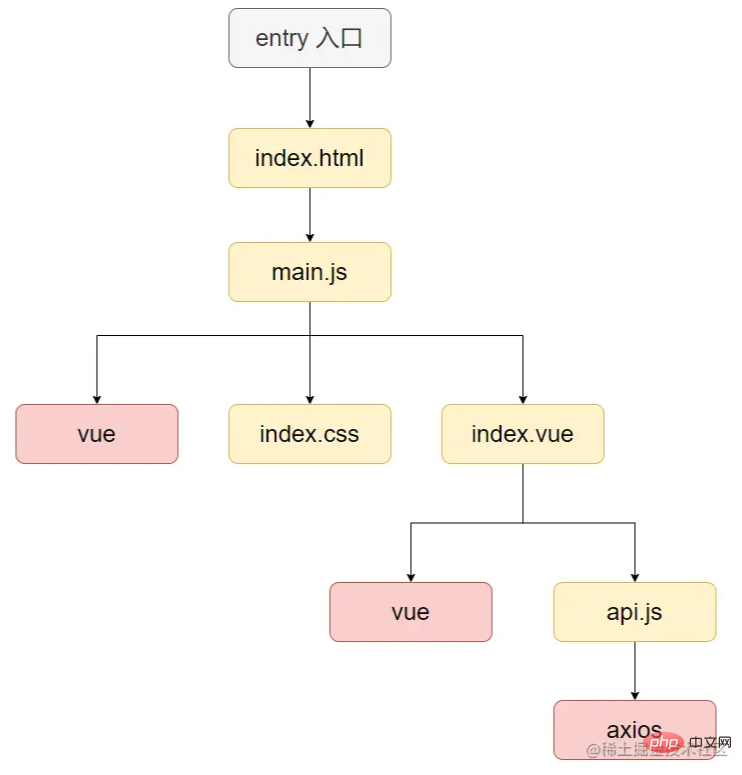
依賴掃描的結果如下:
[ "vue", "axios" ]
為什麼只對 bare import 進行預構建?
Node.js 定義了 bare import 的定址機制 —— 在當前目錄下的 node_modules 下尋找,找不到則往上一級目錄的 node_modules,直到目錄為根路徑,不能再往上。
bare import 一般是 npm 安裝的模組,是第三方的模組,不是我們自己寫的程式碼,一般情況下是不會被修改的,因此對這部分的模組提前執行構建,有利於提升效能。
相反,如果對開發者寫的程式碼執行預構建,將專案打包成 chunk 檔案,當開發者修改程式碼時,就需要重新執行構建,再打包成 chunk 檔案,這個過程反而會影響效能。
monorepo 下的模組也會被預構建嗎?
不會。因為 monorepo 的情況下,部分模組雖然是 bare import,但這些模組也是開發者自己寫的,不是第三方模組,因此 Vite 沒有對該部分的模組執行預構建。
實際上,Vite 會判斷模組的實際路徑,是否在 node_modules 中:
- 實際路徑在 node_modules 的模組會被預構建,這是第三方模組
- 實際路徑不在 node_modules 的模組,證明該模組是通過檔案連結,連結到 node_modules 內的(monorepo 的實現方式),是開發者自己寫的程式碼,不執行預構建
依賴掃描
實現思路
我們再來看看這棵模組依賴樹:
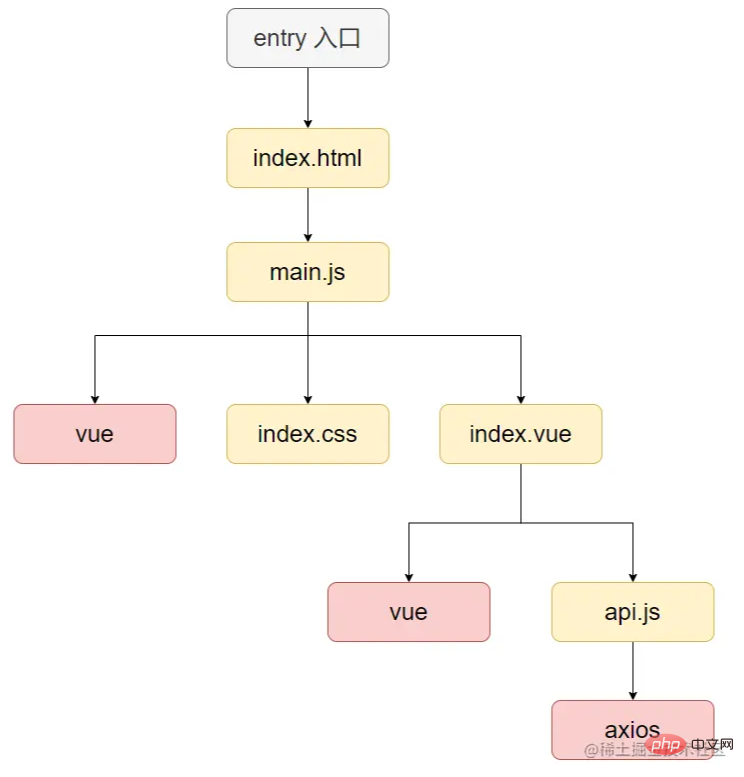
要掃描出所有的 bare import,就需要遍歷整個依賴樹,這就涉及到了樹的深度遍歷
當我們在討論樹的遍歷時,一般會關注這兩點:
- 什麼時候停止深入?
- 如何處理葉子節點?
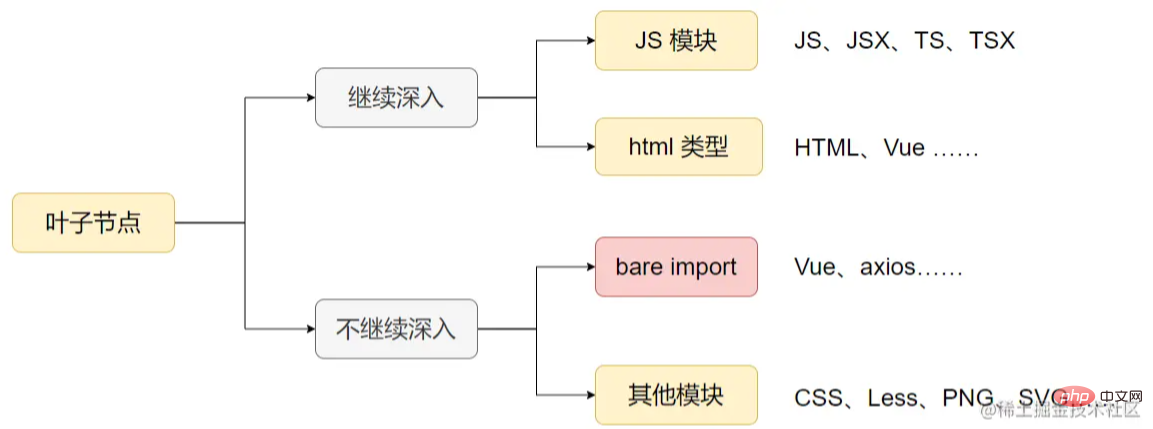
當前葉子節點不需要繼續深入遍歷的情況:
- 當遇到 bare import 節點時,記錄下該依賴,就不需要繼續深入遍歷
- 遇到其他 JS 無關的模組,如 CSS、SVG 等,因為不是 JS 程式碼,因此也不需要繼續深入遍歷
當所有的葉子節點遍歷完成後,記錄的 bare import 物件,就是依賴掃描的結果。
依賴掃描的實現思路其實非常容易理解,但實際的處理就不簡單了。
我們來看看葉子節點的處理:
- bare import
可以通過模組 id 判斷,模組 id 不為路徑的模組,就是 bare import。遇到這些模組則記錄依賴,不再深入遍歷。
- 其他 JS 無關的模組
可以通過模組的字尾名判斷,例如遇到 *.css 的模組,無需任何處理,不再深入遍歷。
- JS 模組
要獲取 JS 程式碼中依賴的子模組,就需要將程式碼轉成 AST,獲取其中 import 語句引入的模組,或者正則匹配出所有 import 的模組,然後繼續深入遍歷這些模組
- HTML 型別模組
這類模組比較複雜,例如 HTML 或 Vue,裡面有一部分是 JS,需要把這部分 JS 程式碼提取出來,然後按 JS 模組進行分析處理,繼續深入遍歷這些模組。這裡只需要關心 JS 部分,其他部分不會引入模組。
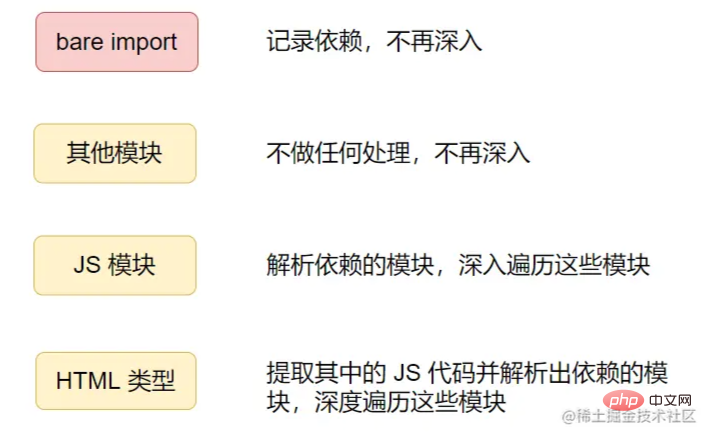
具體實現
我們已經知道了依賴掃描的實現思路,思路其實不復雜,複雜的是處理過程,尤其是 HTML、Vue 等模組的處理。
Vite 這裡用了一種比較巧妙的辦法 —— 用 esbuild 工具打包
為什麼可以用 esbuild 打包代替深度遍歷的過程?
本質上打包過程也是個深度遍歷模組的過程,其替代的方式如下:
| 深度遍歷 | esbuild 打包 |
|---|---|
| 葉子節點的處理 | esbuild 可以對每個模組(葉子節點)進行解析和載入 可以通過外掛對這兩個過程進行擴充套件,加入一些特殊的邏輯 例如將 html 在載入過程中轉換為 js |
| 不深入處理模組 | esbuild 可以在解析過程,指定當前解析的模組為 external 則 esbuild 不再深入解析和載入該模組。 |
| 深入遍歷模組 | 正常解析模組(什麼都不做,esbuild 預設行為),返回模組的檔案真實路徑 |
這塊暫時看不懂沒有關係,後面會有例子
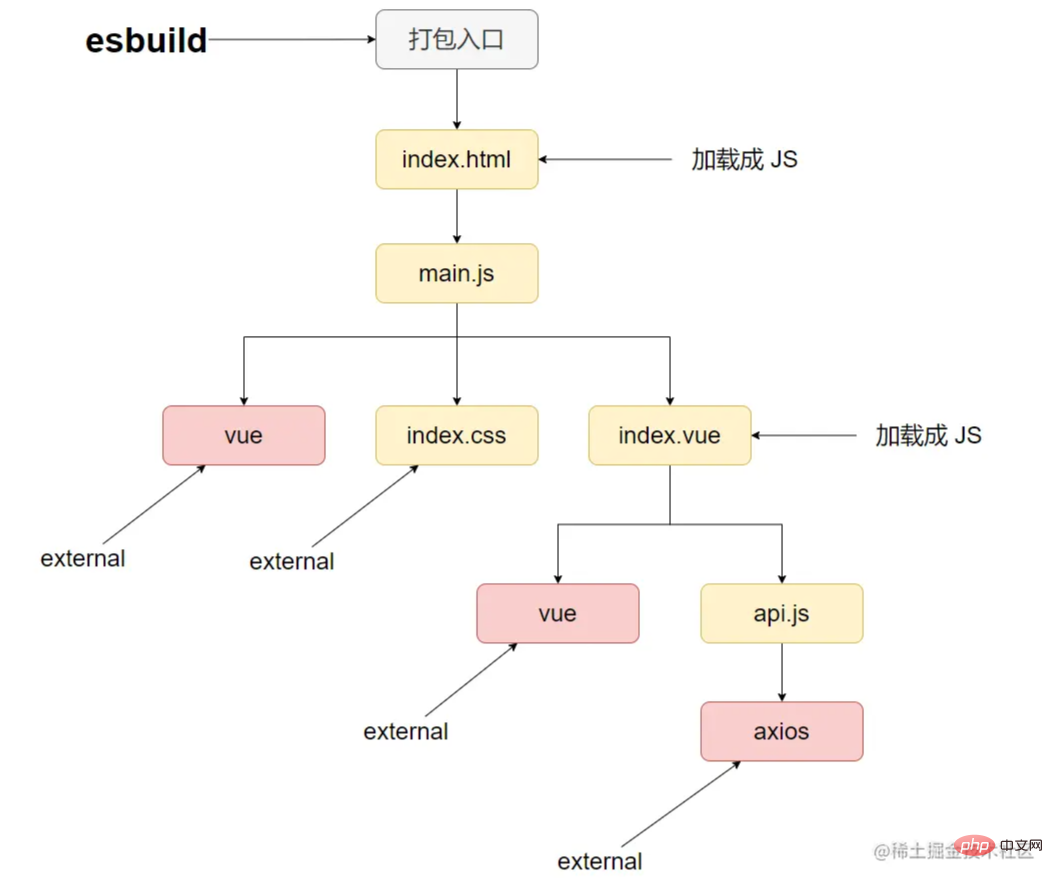
各類模組的處理
| 例子 | 處理 | |
|---|---|---|
| bare import | vue | 在解析過程中,將裸依賴儲存到 deps 物件中,設定為 external |
| 其他 JS 無關的模組 | less檔案 | 在解析過程中,設定為 external |
| JS 模組 | ./mian.ts | 正常解析和載入即可,esbuild 本身能處理 JS |
| html 型別模組 | index.html、app.vue | 在載入過程中,將這些模組載入成 JS |
最後 dep 物件中收集到的依賴就是依賴掃描的結果,而這次 esbuild 的打包產物,其實是沒有任何作用的,在依賴掃描過程中,我們只關心每個模組的處理過程,不關心構建產物
用 Rollup 處理可以嗎?
其實也可以,打包工具基本上都會有解析和載入的流程,也能對模組進行 external
但是 esbuild 效能更好
html 型別的模組處理
這類檔案有 html、vue 等。之前我們提到了要將它們轉換成 JS,那麼到底要如何轉換呢?

由於依賴掃描過程,只關注引入的 JS 模組,因此可以直接丟棄掉其他不需要的內容,直接取其中 JS
html 型別檔案(包括 vue)的轉換,有兩種情況:
- 每個外部 script,會直接轉換為
import語句,引入外部 script - 每個內聯 script,其內容將會作為虛擬模組被引入。
什麼是虛擬模組?
是模組的內容並非直接從磁碟中讀取,而是編譯時生成。
舉個例子,src/main.ts 是磁碟中實際存在的檔案,而 virtual-module:D:/project/index.html?id=0 在磁碟中是不存在的,需要藉助打包工具(如 esbuild),在編譯過程生成。
為什麼需要虛擬模組?
因為一個 html 型別檔案中,允許有多個 script 標籤,多個內聯的 script 標籤,其內容無法處理成一個 JS 檔案 (因為可能會有命名衝突等原因)
既然無法將多個內聯 script,就只能將它們分散成多個虛擬模組,然後分別引入了。
原始碼解析
依賴掃描的入口
下面是掃描依賴的入口函數(為了便於理解,有刪減和修改):
import { build } from 'esbuild'
export async function scanImports(config: ResolvedConfig): Promise<{
deps: Record<string, string>
missing: Record<string, string>
}> {
// 將專案中所有的 html 檔案作為入口,會排除 node_modules
let entries: string[] = await globEntries('**/*.html', config)
// 掃描到的依賴,會放到該物件
const deps: Record<string, string> = {}
// 缺少的依賴,用於錯誤提示
const missing: Record<string, string> = {}
// esbuild 掃描外掛,這個是重點!!!
const plugin = esbuildScanPlugin(config, container, deps, missing, entries)
// 獲取使用者設定的 esbuild 自定義設定,沒有設定就是空的
const { plugins = [], ...esbuildOptions } =
config.optimizeDeps?.esbuildOptions ?? {}
await Promise.all(
// 入口可能不止一個,分別用 esbuid 打包
entries.map((entry) =>
// esbuild 打包
build({
absWorkingDir: process.cwd(),
write: false,
entryPoints: [entry],
bundle: true,
format: 'esm',
// 使用外掛
plugins: [...plugins, plugin],
...esbuildOptions
})
)
)
return {
deps,
missing
}
}主要流程如下:
將專案內所有的 html 作為入口檔案(排除 node_modules)。
將每個入口檔案,用 esbuild 進行打包
這裡的核心其實是 esbuildScanPlugin 外掛的實現,它定義了各類模組(葉子節點)的處理方式。
function esbuildScanPlugin(config, container, deps, missing, entries){}dep、missing物件被當做入參傳入,在函數中,這兩個物件的內容會在打包(外掛執行)過程中被修改
esbuild 外掛
很多同學可能不知道 esbuild 外掛是如何編寫的,這裡簡單介紹一下:
每個模組都會經過解析(resolve)和載入(load)的過程:
- 解析:將模組路徑,解析成檔案真實的路徑。例如
vue,會解析到實際 node_modules 中的 vue 的入口 js 檔案 - 載入:根據解析的路徑,讀取檔案的內容

外掛可以客製化化解析和載入的過程,下面是一些外掛範例程式碼:
const plugin = {
name: 'xxx',
setup(build) {
// 客製化解析過程,所有的 http/https 的模組,都會被 external
build.onResolve({ filter: /^(https?:)?\/\// }, ({ path }) => ({
path,
external: true
}))
// 客製化解析過程,給所有 less 檔案 namespace: less 標記
build.onResolve({ filter: /.*\.less/ }, args => ({
path: args.path,
namespace: 'less',
}))
// 定義載入過程:只處理 namespace 為 less 的模組
build.onLoad({ filter: /.*/, namespace: 'less' }, () => {
const raw = fs.readFileSync(path, 'utf-8')
const content = // 省略 less 處理,將 less 處理成 css
return {
contents,
loader: 'css'
}
})
}
}- 通過
onResolve、onLoad定義解析和載入過程 onResolve的第一個引數為過濾條件,第二個引數為回撥函數,解析時呼叫,返回值可以給模組做標記,如external、namespace(用於過濾),還需要返回模組的路徑- 每個模組,
onResolve會被依次呼叫,直到回撥函數返回有效的值,後面的不再呼叫。如果都沒有有效返回,則使用預設的解析方式 onLoad的第一個引數為過濾條件,第二個引數為回撥函數,載入時呼叫,可以讀取檔案的內容,然後進行處理,最後返回載入的內容。- 每個模組,
onLoad會被依次呼叫,直到回撥函數返回有效的值,後面的不再呼叫。如果都沒有有效返回,則使用預設的載入方式。
掃描外掛的實現
function esbuildScanPlugin( config: ResolvedConfig, container: PluginContainer, depImports: Record<string, string>, missing: Record<string, string>, entries: string[] ): Plugin
部分引數解析:
config:Vite 的解析好的使用者設定container:這裡只會用到container.resolveId的方法,這個方法能將模組路徑轉成真實路徑。例如
vue轉成xxx/node_modules/dist/vue.esm-bundler.js。depImports:用於儲存掃描到的依賴物件,外掛執行過程中會被修改missing:用於儲存缺少的依賴的物件,外掛執行過程中會被修改entries:儲存所有入口檔案的陣列
esbuild 預設能將模組路徑轉成真實路徑,為什麼還要用
container.resolveId?
因為 Vite/Rollup 的外掛,也能擴充套件解析的流程,例如 alias 的能力,我們常常會在專案中用 @ 的別名代表專案的 src 路徑。
因此不能用 esbuild 原生的解析流程進行解析。
container(外掛容器)用於相容 Rollup 外掛生態,用於保證 dev 和 production 模式下,Vite 能有一致的表現。感興趣的可檢視《Vite 是如何相容 Rollup 外掛生態的》
這裡 container.resolveId 會被再次包裝一成 resolve 函數(多了快取能力)
const seen = new Map<string, string | undefined>()
const resolve = async (
id: string,
importer?: string,
options?: ResolveIdOptions
) => {
const key = id + (importer && path.dirname(importer))
// 如果有快取,就直接使用快取
if (seen.has(key)) {
return seen.get(key)
}
// 將模組路徑轉成真實路徑
const resolved = await container.resolveId(
id,
importer && normalizePath(importer),
{
...options,
scan: true
}
)
// 快取解析過的路徑,之後可以直接獲取
const res = resolved?.id
seen.set(key, res)
return res
}那麼接下來就是外掛的實現了,先回顧一下之前寫的各類模組的處理:
| 例子 | 處理 | |
|---|---|---|
| bare import | vue | 在解析過程中,將裸依賴儲存到 deps 物件中,設定為 external |
| 其他 JS 無關的模組 | less檔案 | 在解析過程中,設定為 external |
| JS 模組 | ./mian.ts | 正常解析和載入即可,esbuild 本身能處理 JS |
| html 型別模組 | index.html、app.vue | 在載入過程中,將這些模組載入成 JS |
JS 模組
esbuild 本身就能處理 JS 語法,因此 JS 是不需要任何處理的,esbuild 能夠分析出 JS 檔案中的依賴,並進一步深入處理這些依賴。
其他 JS 無關的模組
// external urls
build.onResolve({ filter: /^(https?:)?\/\// }, ({ path }) => ({
path,
external: true
}))
// external css 等檔案
build.onResolve(
{
filter: /\.(css|less|sass|scss|styl|stylus|pcss|postcss|json|wasm)$/
},
({ path }) => ({
path,
external: true
}
)
// 省略其他 JS 無關的模組這部分處理非常簡單,直接匹配,然後 external 就行了
bare import
build.onResolve(
{
// 第一個字串為字母或 @,且第二個字串不是 : 冒號。如 vite、@vite/plugin-vue
// 目的是:避免匹配 window 路徑,如 D:/xxx
filter: /^[\w@][^:]/
},
async ({ path: id, importer, pluginData }) => {
// depImports 為
if (depImports[id]) {
return externalUnlessEntry({ path: id })
}
// 將模組路徑轉換成真實路徑,實際上呼叫 container.resolveId
const resolved = await resolve(id, importer, {
custom: {
depScan: { loader: pluginData?.htmlType?.loader }
}
})
// 如果解析到路徑,證明找得到依賴
// 如果解析不到路徑,則證明找不到依賴,要記錄下來後面報錯
if (resolved) {
if (shouldExternalizeDep(resolved, id)) {
return externalUnlessEntry({ path: id })
}
// 如果模組在 node_modules 中,則記錄 bare import
if (resolved.includes('node_modules')) {
// 記錄 bare import
depImports[id] = resolved
return {
path,
external: true
}
}
// isScannable 判斷該檔案是否可以掃描,可掃描的檔案有 JS、html、vue 等
// 因為有可能裸依賴的入口是 css 等非 JS 模組的檔案
else if (isScannable(resolved)) {
// 真實路徑不在 node_modules 中,則證明是 monorepo,實際上程式碼還是在使用者的目錄中
// 是使用者自己寫的程式碼,不應該 external
return {
path: path.resolve(resolved)
}
} else {
// 其他模組不可掃描,直接忽略,external
return {
path,
external: true
}
}
} else {
// 解析不到依賴,則記錄缺少的依賴
missing[id] = normalizePath(importer)
}
}
)- 如果檔案在 node_modules 中,才認為是 bare import,記錄當前模組
- 檔案不在 node_modules 中,則是 monorepo,是使用者自己寫的程式碼
- 如果這些程式碼 isScanable 可掃描(即含有 JS 程式碼),則繼續深入處理
- 其他非 JS 模組,external
html 型別模組
如: index.html、app.vue
const htmlTypesRE = /\.(html|vue|svelte|astro)$/
// html types: 提取 script 標籤
build.onResolve({ filter: htmlTypesRE }, async ({ path, importer }) => {
// 將模組路徑,轉成檔案的真實路徑
const resolved = await resolve(path, importer)
if (!resolved) return
// 不處理 node_modules 內的
if (resolved.includes('node_modules'){
return
}
return {
path: resolved,
// 標記 namespace 為 html
namespace: 'html'
}
})解析過程很簡單,只是用於過濾掉一些不需要的模組,並且標記 namespace 為 html
真正的處理在載入階段:

// 正則,匹配例子: <script type=module></script>
const scriptModuleRE = /(<script\b[^>]*type\s*=\s*(?:"module"|'module')[^>]*>)(.*?)<\/script>/gims
// 正則,匹配例子: <script></script>
export const scriptRE = /(<script\b(?:\s[^>]*>|>))(.*?)<\/script>/gims
build.onLoad(
{ filter: htmlTypesRE, namespace: 'html' },
async ({ path }) => {
// 讀取原始碼
let raw = fs.readFileSync(path, 'utf-8')
// 去掉註釋,避免後面匹配到註釋
raw = raw.replace(commentRE, '<!---->')
const isHtml = path.endsWith('.html')
// scriptModuleRE: <script type=module></script>
// scriptRE: <script></script>
// html 模組,需要匹配 module 型別的 script,因為只有 module 型別的 script 才能使用 import
const regex = isHtml ? scriptModuleRE : scriptRE
// 重置正規表示式的索引位置,因為同一個正規表示式物件,每次匹配後,lastIndex 都會改變
// regex 會被重複使用,每次都需要重置為 0,代表從第 0 個字元開始正則匹配
regex.lastIndex = 0
// load 勾點返回值,表示載入後的 js 程式碼
let js = ''
let scriptId = 0
let match: RegExpExecArray | null
// 匹配原始碼的 script 標籤,用 while 迴圈,因為 html 可能有多個 script 標籤
while ((match = regex.exec(raw))) {
// openTag: 它的值的例子: <script type="module" src="xxx">
// content: script 標籤的內容
const [, openTag, content] = match
// 正則匹配出 openTag 中的 type 和 lang 屬性
const typeMatch = openTag.match(typeRE)
const type =
typeMatch && (typeMatch[1] || typeMatch[2] || typeMatch[3])
const langMatch = openTag.match(langRE)
const lang =
langMatch && (langMatch[1] || langMatch[2] || langMatch[3])
// 跳過 type="application/ld+json" 和其他非 non-JS 型別
if (
type &&
!(
type.includes('javascript') ||
type.includes('ecmascript') ||
type === 'module'
)
) {
continue
}
// esbuild load 勾點可以設定 應的 loader
let loader: Loader = 'js'
if (lang === 'ts' || lang === 'tsx' || lang === 'jsx') {
loader = lang
} else if (path.endsWith('.astro')) {
loader = 'ts'
}
// 正則匹配出 script src 屬性
const srcMatch = openTag.match(srcRE)
// 有 src 屬性,證明是外部 script
if (srcMatch) {
const src = srcMatch[1] || srcMatch[2] || srcMatch[3]
// 外部 script,改為用 import 用引入外部 script
js += `import ${JSON.stringify(src)}\n`
} else if (content.trim()) {
// 內聯的 script,它的內容要做成虛擬模組
// 快取虛擬模組的內容
// 一個 html 可能有多個 script,用 scriptId 區分
const key = `${path}?id=${scriptId++}`
scripts[key] = {
loader,
content,
pluginData: {
htmlType: { loader }
}
}
// 虛擬模組的路徑,如 virtual-module:D:/project/index.html?id=0
const virtualModulePath = virtualModulePrefix + key
js += `export * from ${virtualModulePath}\n`
}
}
return {
loader: 'js',
contents: js
}
}
)載入階段的主要做有以下流程:
- 讀取檔案原始碼
- 正則匹配出所有的 script 標籤,並對每個 script 標籤的內容進行處理
- 外部 script,改為用 import 引入
- 內聯 script,改為引入虛擬模組,並將對應的虛擬模組的內容快取到 script 物件。
- 最後返回轉換後的 js
srcMatch[1] || srcMatch[2] || srcMatch[3] 是幹嘛?
我們來看看匹配的表示式:
const srcRE = /\bsrc\s*=\s*(?:"([^"]+)"|'([^']+)'|([^\s'">]+))/im
因為 src 可以有以下三種寫法:
- src="xxx"
- src='xxx'
- src=xxx
三種情況會出現其中一種,因此是三個捕獲組
虛擬模組是如何載入成對應的 script 程式碼的?
export const virtualModuleRE = /^virtual-module:.*/
// 匹配所有的虛擬模組,namespace 標記為 script
build.onResolve({ filter: virtualModuleRE }, ({ path }) => {
return {
// 去掉 prefix
// virtual-module:D:/project/index.html?id=0 => D:/project/index.html?id=0
path: path.replace(virtualModulePrefix, ''),
namespace: 'script'
}
})
// 之前的內聯 script 內容,儲存到 script 物件,載入虛擬模組的時候取出來
build.onLoad({ filter: /.*/, namespace: 'script' }, ({ path }) => {
return scripts[path]
})虛擬模組的載入很簡單,直接從 script 物件中,讀取之前快取起來的內容即可。
這樣之後,我們就可以把 html 型別的模組,轉換成 JS 了
掃描結果
下面是一個 depImport 物件的例子:
{
"vue": "D:/app/vite/node_modules/.pnpm/[email protected]/node_modules/vue/dist/vue.runtime.esm-bundler.js",
"vue/dist/vue.d.ts": "D:/app/vite/node_modules/.pnpm/[email protected]/node_modules/vue/dist/vue.d.ts",
"lodash-es": "D:/app/vite/node_modules/.pnpm/[email protected]/node_modules/lodash-es/lodash.js"
}- key:模組名稱
- value:模組的真實路徑
總結
依賴掃描是預構建前的一個非常重要的步驟,這決定了 Vite 需要對哪些依賴進行預構建。
本文介紹了 Vite 會對哪些內容進行依賴預構建,然後分析了實現依賴掃描的基本思路 —— 深度遍歷依賴樹,並對各種型別的模組進行處理。然後介紹了 Vite 如何巧妙的使用 esbuild 實現這一過程。最後對這部分的原始碼進行了解析:
- 最複雜的就是 html 型別模組的處理,需要使用虛擬模組;
- 當遇到 bare import 時,需要判斷是否在 node_modules 中,在的才記錄依賴,然後 external。
- 其他 JS 無關的模組就直接 external
- JS 模組由於 esbuild 本身能處理,不需要做任何的特殊操作
最後獲取到的 depImport 是一個記錄依賴以及其真實路徑的物件
(學習視訊分享:、)
以上就是Vite學習之深度解析「依賴掃描」的詳細內容,更多請關注TW511.COM其它相關文章!
